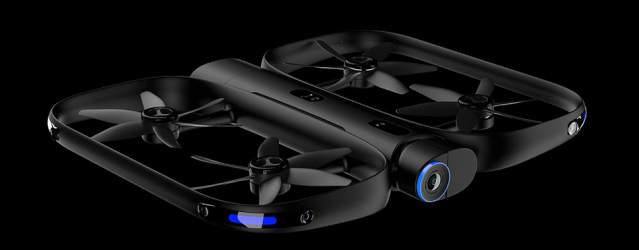Skydio: Alumni Invent Autonomous Selfie Drone
-
-
MIT News
Filed Under
Recommended

If you’re a rock climber, hiker, runner, dancer, or anyone who likes recording themselves while in motion, a personal drone companion can now do all the filming for you — completely autonomously.
Skydio, a San Francisco-based startup founded by three MIT alumni, is commercializing an autonomous video-capturing drone — dubbed by some as the selfie drone — that tracks and films a subject, while freely navigating any environment.
Called R1, the drone is equipped with 13 cameras that capture omnidirectional video. It launches and lands through an app — or by itself. On the app, the R1 can also be preset to certain filming and flying conditions or controlled manually.
The concept for the R1 started taking shape almost a decade ago at MIT, where the co-founders — Adam Bry SM ’12, Abraham Bacharach PhD ’12, and Matt Donahoe SM ’11 — first met and worked on advanced, prize-winning autonomous drones. Skydio launched in 2014 and is releasing the R1 to consumers in March.
“Our goal with our first product is to deliver on the promise of an autonomous flying camera that understands where you are, understands the scene around it, and can move itself to capture amazing video you wouldn’t otherwise be able to get,” says Bry, co-founder and CEO of Skydio.
The foundation of the [Skydio] technology… all started at MIT.
Existing drones, Bry says, generally require a human pilot. Skydio, on the other hand, “is like a driverless car with level-four autonomy,” he says, referring to the second-highest level of vehicle automation.
R1’s system integrates advanced algorithm components spanning perception, planning, and control, which give it unique intelligence “that’s analogous to how a person would navigate an environment,” Bry says.
On the perception side, the system uses computer vision to determine the location of objects. Using a deep neural network, it compiles information on each object and identifies each individual by, say, clothing and size. “For each person it sees, it builds up a unique visual identification to tell people apart and stays focused on the right person,” Bry says.
That data feeds into a motion-planning system, which pinpoints a subject’s location and predicts their next move. It also recognizes maneuvering limits in one area to optimize filming. “All information is constantly traded off and balanced … to capture a smooth video,” Bry says.
Finally, the control system takes all information to execute the drone’s plan in real time. “No other system has this depth of understanding,” Bry says. Others may have one or two components, “but none has a full, end-to-end, autonomous [software] stack designed and integrated together.”
For users, the end result, Bry says, is a drone that’s as simple to use as a camera app: “If you’re comfortable taking pictures with your iPhone, you should be comfortable using R1 to capture video.”
The lightweight drone can fit into an average backpack and runs about $2,500.
When Bry came to MIT in 2009, he joined the Robust Robotics Group, led by Nick Roy, an expert in drone autonomy. There, he met Bacharach, now Skydio’s chief technology officer, who that year was on a team that won the Association for Unmanned Vehicles International contest with an autonomous minihelicopter that navigated the aftermath of a mock nuclear meltdown. Donahoe was a friend and graduate student at the MIT Media Lab at the time.
In 2012, Bry and Bacharach helped develop autonomous-control algorithms that could calculate a plane’s trajectory and determine its “state” — its location, physical orientation, velocity, and acceleration. In a series of test flights, a drone running their algorithms maneuvered around pillars in the parking garage under MIT’s Stata Center and through the Johnson Athletic Center.
These experiences were the seeds of Skydio, Bry says: “The foundation of the [Skydio] technology, and how all the technology works and the recipe for how all of it comes together, all started at MIT.”
For more details about the technology, read the full MIT News Office story.








